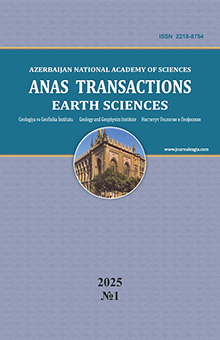№ 2,
2018
Download the article
Transgression and regression of Caspian paleo-basin on paleomagnetic data
1 – Geology and Geophysics Institute, ANAS, H.Javid Ave., 119, Baku, Azerbaijan, AZ1143; znovruz@yahoo.com
2 – Institute of Physics of the Earth RAS, Bolshaya Gruzinskaya, 10, Moscow, Russia, 123995
3 – Geological Institute RAS, Pyzhevsky lane 7, Moscow, 119017
Summary
A-
A+
Magnetic minerals of rocks are sensitive to the rock formation environment and subsequent lifecycle. This sensitivity is reasoned by two cases: by variable iron valency and by relative instability of the rocks formed within accumulation. For the study reasons, a number of cross-sections were reviewed. The cross-section in Karaja which is located 10 km away from Mingachevir town with coordinates λ = 47°E, φ = 40°N, is characterized by complete sequence of Pleistocene sediments. The research of marine sediments was objective of the current study. The mentioned section, by completeness and representativeness, is unique for paleomagnetic study of Paleo-Caspian Basin. The abundance of fauna and layers of volcanic ash allow dating of the studied geological events. As a result of petro-magnetic researches, the regular relationship between variations of magnetic parameters of rocks and transgressive-regressive sea level behavior of Paleo-Caspian Basin was determined. These transgression-regression cycles were caused by tectonic activity in the Caucasian region and by global climatic changes.
Keywords: marine, lagoon deposits, Pleistocene, paleomagnetism
REFERENCE
Dearing J. Magnetic susceptibility. In: Walden J., Smith J.P., Oldfield F., (Editors). Environmental Magnetism: a practical guide, Quaternary Research Association. London. Technical Guide, № 6, 1999, pp. 35-62.
Dodonov A.E., Tchepalyga A.L., Mihailescu C.D., Zhou L.P., Markova A.K., Trubikhin V.M., Simahova A.N., Konikov E.G. Last-interglacial records from central Asia to the northern Black Sea shoreline: stratigraphy correlation. Netherlands Journal of Geosciences, V. 79, №2/3, 2000, pp. 303-311.
King J.W., Channell J.E.T. Sedimentary magnetism, environmental magnetism, and magnetostratigraphy. U.S. Nat. Rep. Int. Union Geod.Geophys.Rev. Geophys. 1987-1990, V. 29, 1991, pp. 358-370.
Lowrie W. Identification of ferromagnetic minerals in a rock by coercivity and unblocking temperature properties. Geophys. Res. Lett., V. 17(2), 1990, pp. 159-162.
Mammadov A.B., Aleskerov B.D. Pleistocene of Azerbaijan. Azerbaijan National Academy of Sciences. Institute of Geography. Baku. 2002, 70 p. (in Russian).
Pilipenko O.V., Sharonova Z.V., Trubikhin V.M., Novruzov Z., Karyagdy S.K., Abrakhamsen N. Study of environmental change of Karaja section rocks formation (Azerbaijan) on results of petromagnetic research. Earth Physics, № 4, 2009, pp. 85-96 (in Russian).
Trubikhin V.M. Paleomagnetic method and dating of regional geological events of Pontian-Caspian. New data on geochronology of Quaternary period, Nauka. Moscow, 1987, pp. 150-157 (in Russian).
DOI:
10.33677/ggianas20180200016
